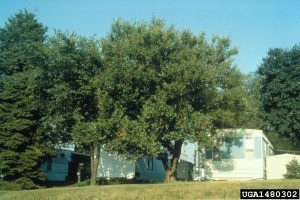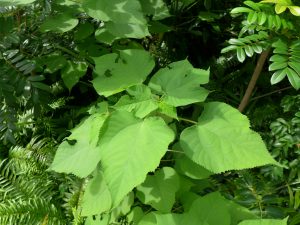Red Mulberry, Morus rubra

Photo by dogtooth77

Photo by Richard Webb, Bugwood.org

Photo by Scott Zona
Height: 40 to 70 feet
Spread: 40 to 50 feet
LANDSCAPE USE
Serves well as a specimen or shade tree, along woodland edges, in a shady understory, or in naturalistic landscapes.
FORM
An erect, single-trunked, fast-growing, deciduous tree with a short trunk, spreading crown, and large, coarsely textured leaves.
NATIVE RANGE
Floodplains, hammocks, and mesic slopes. Southeastern United States, south to and nearly throughout Florida.
CHARACTERISTICS
Flowers: Small, greenish, mostly inconspicuous, borne in 2- to 3-inch-long spikes. Male and female flowers borne on separate plants. Spring and summer.
Leaves: Simple, alternate, 3-10 inches long and nearly as wide, ovate to nearly oval in outline and pinched to a point at the apex; margins toothed, sometimes deeply lobed, especially on vigorous shoots and root sprouts. Stalk exudes a milky latex when broken.
Fruit: A 1-inch-long aggregate fruit, red to dark purple when mature; juicy and relished by birds. Late summer and fall.
Bark: Gray brown to brown; furrowed, with flattened ridges
CULTURE
Soil: Fertile, moist, acid to alkaline soils.
Exposure: Full sun to part shade.
Water: Prefers moist conditions. Irrigation generally not required when properly sited and after becoming established.
Hardiness Zones: 7 to 10.
Life Span: Relatively short; probably less than 100 years.
BEST FEATURES including WILDLIFE SUPPORT
Fall color. Fruit relished by all kinds of wildlife, including migrating birds, and people. This tree is dioecious, so you must have male and female plants in proximity to get fruit on the female trees. Larval host for the Red Admiral and Mourning butterfly. Fast growth. Spreading crown.
COMPANION PLANTS
Magnolia (Magnolia grandiflora), Red Buckeye (Aesculus pavia), Sweetshrub (Calycanthus floridus), Flowering Dogwood (Cornus florida), Beautyberry (Callicarpa americana), Oakleaf Hydrangea (Hydrangea quercifolia), Carolina Jessamine (Gelsemium sempervirens), Virginia Creeper (Parthenocissus quinquefolia), Purple Coneflower (Echinacea purpurea).
DISADVANTAGES
Fallen fruit can be messy, especially over paved surfaces. This tree has a relatively long dormancy period.
ALLERGENIC AND TOXIC PROPERTIES
Reported to cause dermatitis, stomach upset, and hallucinations.
SIMILAR AND RELATED SPECIES
The leaves of Basswood (Tilia americana) are very similar but their stalks lack milky sap. Two non-native mulberries arc established in Florida, including White Mulberry (Morus alba) and Paper Mulberry (Broussonetia papyrifera); both should be avoided in favor of this native species.